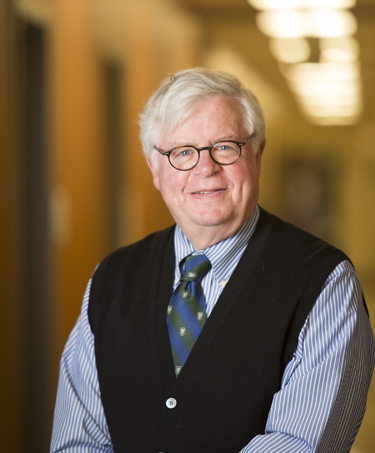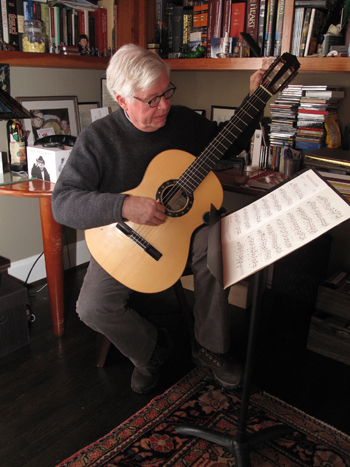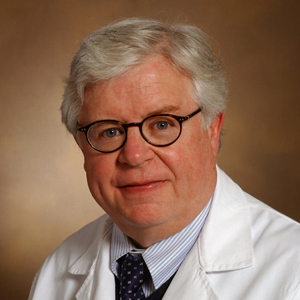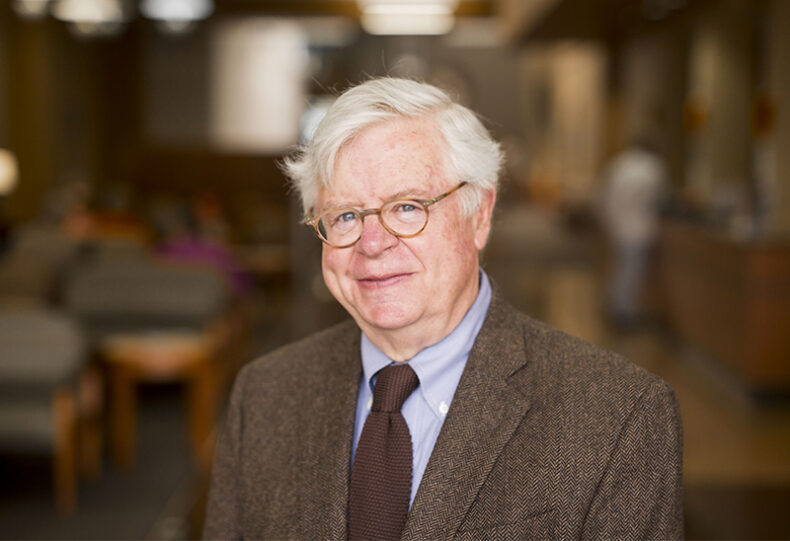When Rob Hood, M.D., began practicing cardiology 30 years ago he could not have imagined that fitness would one day be measured on a device worn around his wrist.

While he has faced, and embraced, changes not only to technology but to his practice and his roles at Vanderbilt over the years, the one constant has been his devotion to his patients.
“My most vivid memory of Dr. Hood was when I was having a transesophageal echo, and I was scared to death,” said Jody Vaughan, a patient of Hood’s for nearly 30 years. “He happened to be in the cath lab just by coincidence and he could see how scared I was and stopped what he was doing to come over and talk to me and reassure me.
“Those few minutes of seeing him and hearing his calming voice meant more to me than I could ever express.”
Although it’s difficult to imagine Hood in a career other than medicine, he took some time coming around to the idea of being a physician. Growing up in New Orleans, the son of a physician, he was more interested in fiction than physics. He graduated from the University of South Florida with a degree in English and then started studies in a graduate degree program in English literature at the University of British Columbia.
“There was a sense of maybe I was expected to go into medicine, but I found myself drawn to literature, and it wasn’t until I was in grad school and I started feeling self-indulgent about a career in academics and literature that I started re-examining what I wanted to do,” Hood said.
Turning to his love of the written word, he read a number of books that changed his thoughts about science and how it works, chief among them “The Structure of Scientific Revolutions” by Thomas Kuhn.
“I changed my focus and thoughts on what I wanted to do and I went back to New Orleans and got a second undergraduate degree in Biochemistry. I decided I wanted to go into medicine,” he explained.
He graduated from Tulane University School of Medicine in 1980 and then went to Emory University in Atlanta for his residency and fellowship.
At that time, J. Willis Hurst, M.D., was chair of the Department of Medicine at Emory. Hurst was the cardiologist for Lyndon B. Johnson and the principal editor of “The Heart,” the most widely used textbook on cardiovascular disease. Andreas Gruentzig, M.D., renowned for performing the first peripheral human balloon angioplasty in 1977, joined Emory’s faculty during Hood’s internship year.
“There was a lot of excitement at Emory with regards to clinical growth, research, and a more aggressive attitude toward cardiovascular disease, and it reinforced that cardiology was something I found attractive,” Hood said.
After completing his fellowship, Hood settled in Nashville and joined Page-Campbell Cardiology Group at Saint Thomas Hospital in 1988.
Over the next two decades, he played an important role in the evolution of that practice, becoming the managing partner. He looks back on those heady days with a sense of nostalgia and a twinkle in his blue eyes.
“Harry Page was a tremendously innovative person responsible for bringing angioplasty to this area. He and his partner, Dr. Campbell, established a top-tier program,” Hood said. “Saint Thomas was a very important part of the teaching program for Vanderbilt, with students rotating through its medical and surgical specialties.”
In the late ‘90s, Vanderbilt began a dialogue with the Page-Campbell group about working together clinically. As a result, Vanderbilt Page-Campbell Heart Institute was established in 1999.
Hood was one of the first Page-Campbell cardiologists who began to spend more of his time on the Vanderbilt campus, specifically in the cardiac cath lab as an interventional cardiologist.
“I provided interventional coverage here and at Saint Thomas as well. That was an exciting time,” Hood said. “This was a unique model, having that kind of partnering between a private group and a university-based group. It was being watched by a number of people across the country because it was really very novel.”

Over the next six years, a growing number of Page-Campbell physicians began seeing patients at Vanderbilt as well as sharing the weekend on-call service. In 2006 Vanderbilt and Page-Campbell officially merged to form the Vanderbilt Heart and Vascular Institute.
“Change can be challenging and even the most positive change can be stressful. There is definitely a shared sense of excitement for the future,” Hood said in a VUMC Reporter interview at the time. “We are all looking forward to the opportunity to work in an environment where we have a collegial relationship with co-workers and can provide the best care while having fun doing it.”
His collaborative nature has not gone unnoticed by Vanderbilt leadership, who have tapped him for a number of administrative roles.
Hood serves as medical director for Vanderbilt Health One Hundred Oaks, associate chief medical officer for Vanderbilt Medical Group and medical director for the Office of Outpatient Referral Assistance.
He continues to see patients in clinic three-and-a-half days a week and in Kentucky once a month. He rounds with residents and medical students for two-week blocks and has participated in a mentoring program with medical students.
“While I do enjoy the on-the-ward teaching, I have also really enjoyed my involvement as a mentor for medical students, which has been afforded by participation in Curriculum 2.0. Being able to share insights which I have retained from my own mentors many years ago has meant as much to me as to my students.”
For Hood, patient care is like a great book you don’t want to end, and he has no interest in closing that chapter. Instead, he continues to strike a balance by spending time with his wife, Kathy, and their adult sons, Alex and Nick, playing classical guitar and cooking. Of course, he also makes time to indulge his love of great literature.
“I have been very, very fortunate to have a remarkably supportive family. It was hard to maintain the amount of family contact I wanted to have, but they were very understanding and supportive. Likewise, I would find ways to try to protect my time with my family,” he said.
Hood sets a great example for his patients by exercising regularly. Staying true to his ability to adapt to change, he purchased a Fitbit activity tracker to determine if it would benefit his patients, whose best interests he always has at heart.















